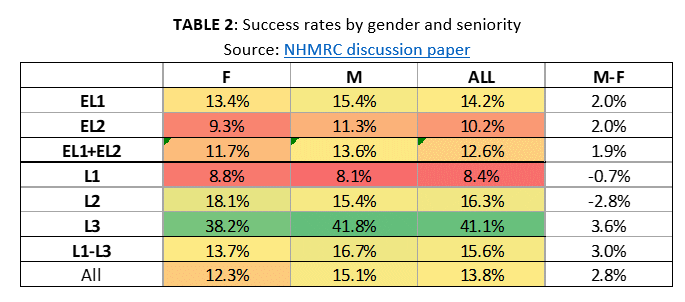Australia punches above its weight for medical research. So when the National Health and Medical Research Council (NHMRC), the main government granting agency in this field announced on October 16th that in future, mid-level and senior grants will be awarded to males and females in exactly equal number, people sat up and took notice.
This move followed, and was to some extent a reaction to, earlier outrage at some of the 2019-2021 statistics listed below, as well as a change.org petition of which the Council was self-consciously aware, despite the fact that "funded rates for women and men have been close to equal since 2017".
What is the background of this decision?
Advertisement
NHMRC grants are highly competitive and only around 14% of applications are successful. The application itself is far from a costless exercise and can take many weeks of full-time work for the lead researcher. An affirmative action element for grants already exists: the Structural Priority Funding scheme allocates a pool of money to unsuccessful female and non-white applicants until it is exhausted.
The table below is for Investigator Grants, which is an important class of grants, but not the only class. Data for some other classes, for instance, Centres for Excellence grants and Synergy grants, suggest that females have enjoyed more success than males. But let's stick with the Investigator grants, which have generated all the controversy and is the grant class that the NHMRC have targeted for intervention.

Around 60% (34.3%+24.8%) of applications are by junior researchers, who are designated Early Leaders. This kind of language speaks to the US style managerialism that has infected much of Australian research and research institutions. A minor point perhaps but culture, especially US culture, is at the heart of this controversy. Nobody wants to be a humble researcher anymore. We need leaders and you best become a leader as early as possible.
Amongst these junior applicants, females are the majority and there were 137 successful females compared to 123 males. Indeed, females make up the majority of those employed in medical research among the under 30's. As we move into the more senior researcher levels though, males dominate applications, largely reflecting their legacy dominance in the industry. And because success rates tend to be higher for more senior applicants, this results in more overall grants to male applicants (422 compared to 313). That the demographic skew is the main cause of the gender difference is not just my opinion. It is stated by the NHMRC CEO Ann Kelso last February.

Advertisement
Another way to look at the data is success rates– the proportion of applicants in a given pool who receive a grant, see Table 2. For junior researchers (EL1+EL2) the success rates are 13.6% for males and 11.7% for females. For senior researchers (designated Leaders 1-2) the success rates are 16.7% for males and 13.7% for females. This does appear to indicate a modest tendency for male applicants to have a higher chance of success. However, this data does not adjust for the assessed quality of the project itself, upon which the NHMRC largely base their decisions.
With the new NHMRC policy, female success rates will be close to twice as high as male success rates. This directly conflicts with the claim of the NHMRC CEO Ann Kelso that the "NHMRC is committed to ensuring that all researchers have equal opportunity to undertake health and medical research regardless of their gender".
Two issues: gender dominance versus gender bias
Discuss in our Forums
See what other readers are saying about this article!
Click here to read & post comments.
5 posts so far.